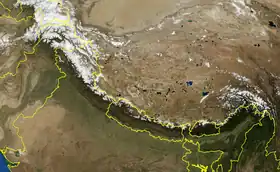Himalayan states
The term Himalayan states is used to group countries that straddle the Himalayas. It primarily denotes Bhutan, China, India, Nepal, and Pakistan; some definitions also include Afghanistan and Myanmar.[1][2] Two countries—Bhutan and Nepal—are located almost entirely within the mountain range, which also covers southern Tibet, the Indian Himalayan Region, and northern Pakistan.[3]
| Himalayan states | |
|---|---|
 Satellite imagery of the Himalayas, with state borders overlaid | |
| Countries | |
The inhabitants of this region are mostly speakers of the Indo-Aryan languages and the Tibeto-Burman languages.[4]
Some of the world's major transboundary rivers originate in the territory of the Himalayan states, including the Brahmaputra, the Ganges, the Indus, and the Irrawaddy.[5]
See also
References
- "The Himalayas". PBS. 11 February 2011. Retrieved 11 February 2011.
- "Myanmar Himalaya Travel".
- Bishop, Barry. "Himalayas (mountains, Asia)". Encyclopædia Britannica. Retrieved 5 June 2016.
- Chatterjee, Shiba. "Himalayas (mountains, Asia)". Encyclopædia Britannica. Retrieved 5 June 2016.
- Wirsing, R.; Jasparro, C.; Stoll, D. (16 November 2012). International Conflict over Water Resources in Himalayan Asia - R. Wirsing, C. Jasparro, D. Stoll - Google Books. ISBN 9781137292193. Retrieved 22 May 2016.
External links
This article is issued from Wikipedia. The text is licensed under Creative Commons - Attribution - Sharealike. Additional terms may apply for the media files.